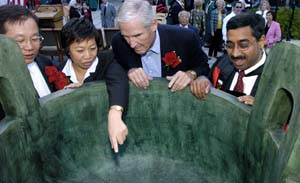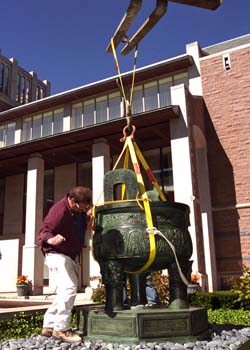The Olin School of Business just got dinged — and that’s good news.
In this case, the ding is not something that requires repair or that mars a reputation. In fact, the ding that was dedicated Sept. 30 is a mark of honor, donated by a group of Executive M.B.A. alumni from the Olin School’s program in Shanghai, China.

The Olin School has conducted an Executive M.B.A. Program in Shanghai for more than four years. It’s run as a joint venture with Fudan University, one of China’s premier educational institutions. The program follows the same curriculum as the E.M.B.A. Program in St. Louis and is taught in English by many of the same professors.
A ding is part of a set of ceremonial bronze vessels, which historically came in a variety of shapes and frequently carried food and wine. The ruling class used the ritual bronzes during ancestor worship rituals, placing the vessels in burial tombs.
Beginning in the Shang dynasty, which lasted from the 16th to the 11th century B.C., large dings were used as gifts from one aristocrat to another. These large dings symbolized authority and the right to rule. The number of dings an aristocrat owned indicated his status: the emperor had nine dings, dukes and barons had seven and scholarly gentlemen, three.
Alumni from the second graduating class of the E.M.B.A.-Shanghai program donated the ding as a symbol of the strong ties they have to Washington University. In Chinese culture, giving gifts is a way of showing ongoing commitment to a person or institution.
The ding that the Olin School received is 5 feet tall, 4 feet in diameter and weighs 1,500 pounds. The gift is a reproduction of the Da Ke Ding — now in the Shanghai Museum — from King Xiao’s reign in the 10th century B.C.
The Chinese Art Institute of Shanghai Jiaotong University made the replica. It was cast at a foundry in Shanghai and has a base inscribed with the names of the donors in Chinese and English.

The ding was placed in the courtyard of the Charles F. Knight Executive Education Center. Eventually the ding will be covered by a custom-made pavilion made of wood and stone, designed by architect Gregory J. Goebel of Riddle Design.
“We feel honored that our E.M.B.A.-Shanghai alumni felt moved to give this symbol of leadership,” said Mahendra Gupta, Ph.D., Olin School dean and the Geraldine J. and Robert L. Virgil Professor in Accounting and Management. “We’re very proud of our relationship with Fudan University, and we are proud of the accomplishments that the 140-plus E.M.B.A.-Shanghai alumni have achieved.
“We look forward to many more years of enhancing and enriching this relationship.”
The ding was dedicated immediately following the graduation ceremony for E.M.B.A.-Shanghai Class of 2005 — the third class to come out of the Olin School’s E.M.B.A.-Shanghai program. By completing the 18-month program, the students became full-fledged alumni of both Washington and Fudan universities.